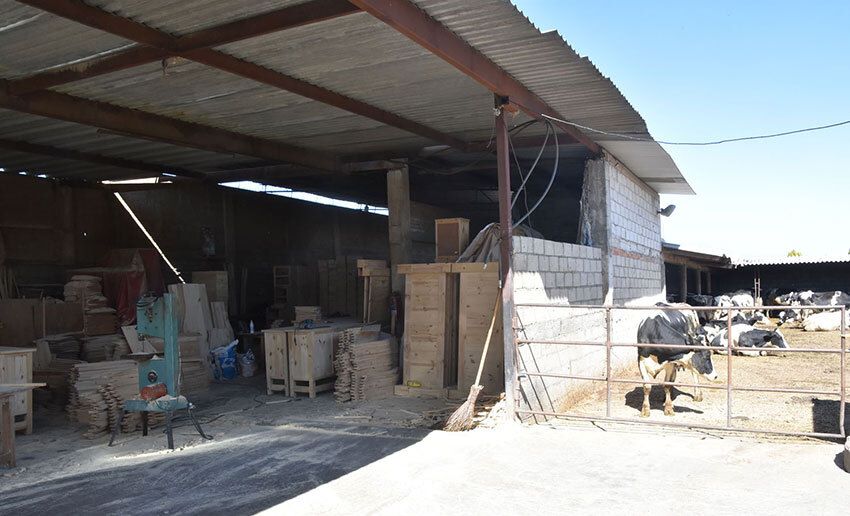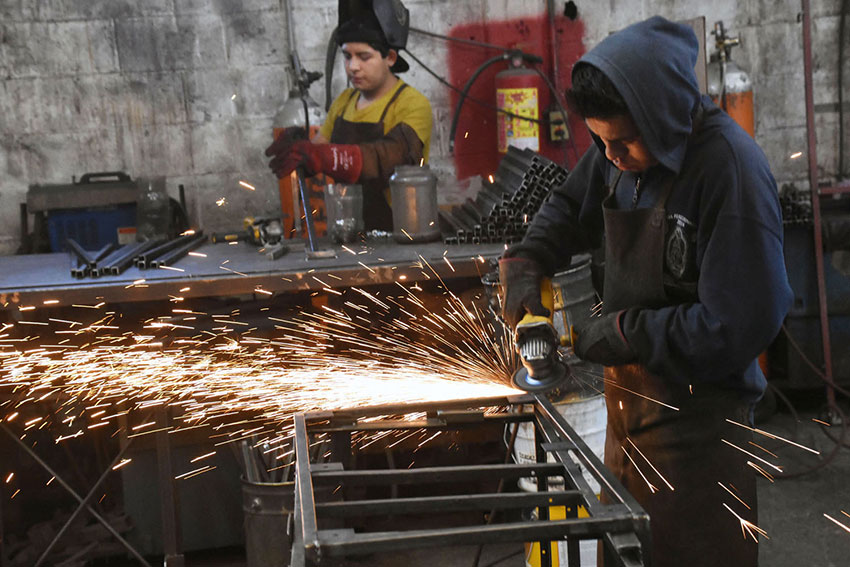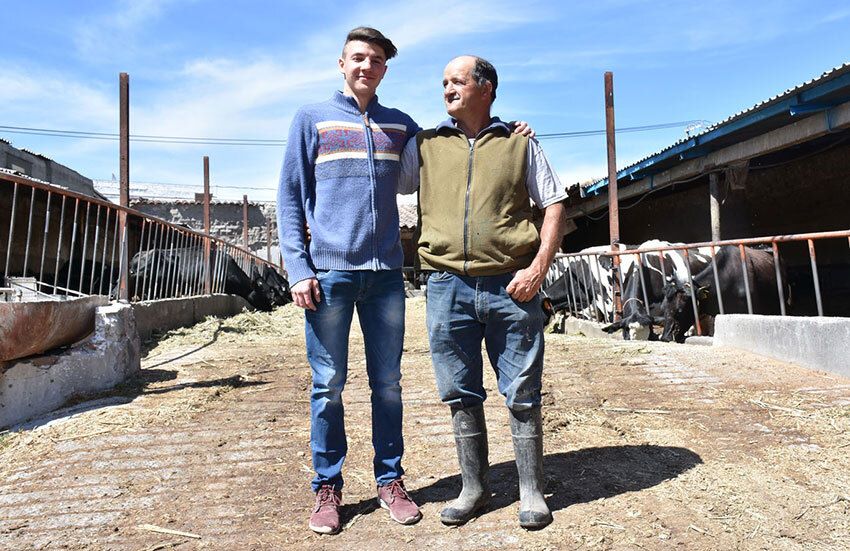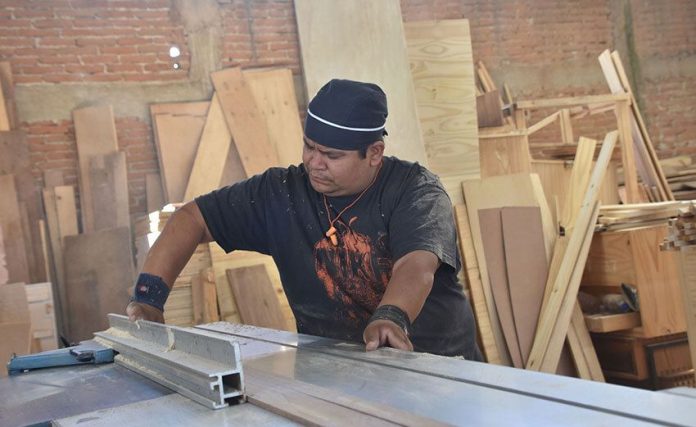The whine of power saws cutting wood in the carpentry shop fills the air while, just a few feet away, a cow calmly chews its cud, looking completely unconcerned. It’s an apt image for what’s happening in Chipilo, a town in Puebla that, for over a hundred years, had been known almost exclusively for its dairy products but now is becoming more famous for its furniture.
“In the future, it will be furniture,” said José Armando Piloni, whose family has had the dairy farm for 38 years and the attached carpentry shop for 25. “The price of milk has dropped; people are consuming less. In two years, we will not have the dairy.”
Chipilo was settled in October 1882 by 38 families from the Veneto region in northern Italy who were enticed to move to Mexico by the government’s promise of free, fertile land. Soon after they arrived, they learned that the land wasn’t always free but it was good, and chipileños (as they’ve come to be called) settled down and started farms and dairies.
It seems like every other building lining Chipilo’s streets houses a dairy or carpentry shop, although the carpentry shops now greatly outnumber the dairies.
“Before there were probably 300 [dairies],” says Antonio Zaraín García, who opened one of the first large furniture factories in the pueblo. “Now, maybe 80 and many have transformed to making furniture.”

Mexico has a long history of furniture-making.
“The Spaniards brought furniture from Spain to Mexico,” said José Eskawratz, the founder and CEO of Mexsol, a furniture exporting company. “Puebla was the first city in the Americas to make furniture. The first items were basic trunks. Of course, there was a lot of Spanish influence.”
Although artisans in Puebla have been making furniture for centuries, the first furniture factory in Chipilo didn’t open until 1970, and it wasn’t until 1982 that Zaraín García started his, which he called Segusino.
“Segusino is … the pueblo in Italy where about 20% of chipileños come from,” he explained. He began attending furniture shows in the U.S. and started exporting furniture, first to California, Washington and Dallas.
In the early 80s, a different style began to develop.
“The style changed to rustic furniture and wood,” said Zaraín García. “It was much stronger.”

According to Eskawratz, that style has an American influence.
“Rustic furniture came out of the [Great] Depression,” he said. “Many Americans survived the Depression by making rustic furniture, putting it on the road in front of their houses and selling it. That’s what, in the 80s, was brought to Chipilo. The Chipilo style, if there is one, is traditional rustic with a wax finish and wrought-iron fittings. It’s solid, heavy furniture. In Chicago, they call this rustic style, ‘hungry furniture.’”
The fact that the style grew out of the Depression doesn’t mean it’s inexpensive.
“In Chipilo, all furniture is made by hand, and it costs more,” added Zaraín García. “A machine makes it perfect, but many people in Europe and the U.S. want furniture made by hand. People feel that it is more like the furniture they remember from their nonna [grandmother] or from the countryside. People value things more when they are made by hand.”
In addition to running Mexsol, Eskawratz has four furniture factories in Chipilo, the largest of which is Seguisino, which his father bought from Zaraín García in 2010. The Seguisino factory, which he renamed Muebles Rústicos y Forjados de Chipilo, is a whirl of activity. In one section, sparks fly as workers cut and weld metal strips together to make frames for the furniture while in others, dust hangs in the air as the wood is cut and assembled into furniture.
“We use pine from Chile, Brazil and Mexico [and] walnut and poplar from the U.S.,” says Eskawratz. “Old wood has been bought from the favelas (slums) in Brazil. They’re paid $10,000 for their shack, and then they build another house out of cinderblock.”

The Seguisino factory alone employs 350 workers and ships out 3,000 to 4,000 pieces a week; his other two factories ship about 2,000 pieces a week each. He estimates that in Chipilo, a pueblo with a population of less than 4,000, about 30,000 people work in the furniture factories and carpentry shops, the workers coming from the 12 surrounding towns.
“Before, they were vaqueros [cowboys] and campesinos [farmers],” said Zaraín García. Now they’re furniture makers.
Although the larger factories dominate furniture manufacturing in Chipilo, there are about a dozen medium-sized ones. Eskawratz figures there are at least 200 small shops. Francisco García Castillo owns one of the small carpentry shops, located a mile or so outside of Chipilo’s town center. Although he never had cows, like many people in Chipilo, he did work in a dairy for some time.
“I have been a carpenter for 20 years,” he told me, “and have had this business for 10.”
He has seven employees and ships 50 or 60 pieces a week — mainly small bureaus and tables — to an exporter. Although his shop is small, he expects the furniture business in Chipilo to keep growing, and he hopes to expand his shop soon.
Piloni, who has both the carpentry shop and the dairy, is finding it increasingly difficult to sustain the latter. He doesn’t have enough land to grow forage, so he has to buy it, adding to his costs, and it’s difficult to find workers. He’d like to get out of the dairy business and put all his energy into furniture, but there’s a problem.
“Right now there are no buyers, only sellers,” he says.
Still, despite the challenges, not everyone in Chipilo’s ready to give up on dairy. Luís Stefanoni Precoma’s dairy has been in his family for four generations, and if Flavio Stefanoni Merlo, his 17-year-old son, has his way, there will be a fifth.
“I will continue with the dairy,” Stefanoni Merlo said proudly. “It is a family tradition.”
The dairy has 300 cows, which he says is large for Chipilo. “You need that many to survive,” he explains.
He is unfazed at the information there are fewer dairies in the pueblo and that many of the owners were looking to transition to furniture-making.
“I believe we can continue. I believe we can grow.” After a pause, he added, “I do not think we will change to furniture.”
Joseph Sorrentino is a regular contributor to Mexico News Daily.
